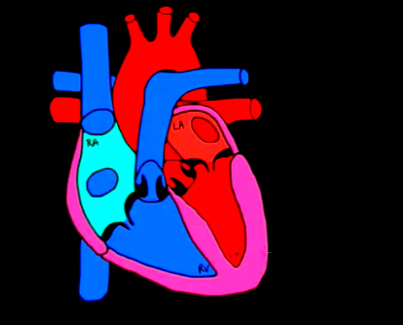So you're probably feeling pretty comfortable with the diagram of the heart,
大家已經熟悉了心臟的構造圖
but let me just go ahead and label a few things,
這里我們再介紹一些名詞
just to make sure we're all on the same page.
加深大家對心臟構成的理解
Blood flows from the right atrium to the right ventricle,
血液從右心房到右心室
then it goes to the lungs and then the left atrium to the left ventricle.
然后進入肺,而后進入左心房,回到左心室
So that's usually the flow of blood.
這就是血液流動路線
And one of the things that keeps the blood flowing in the right direction we know is the valves.
而保證血液順流,方向不出錯的就是瓣膜
Two of the valves I'm actually going to name, I'll give you new names,
給大家介紹兩個瓣膜的新術語
something slightly different from what we've been referring to them by
跟之前介紹的略微不同

These are the atrioventricular valves.
這些都叫房室瓣
You can take a guess as to which ones I'm referring to.
大家可以想一下,房室瓣指的是哪些
Atrioventricular valves are the two valves between the atria and the ventricles.
房室瓣指的就是心房和心室之間的兩個瓣膜
One will be the tricuspid valve and the other the mitral valve.
一個是三尖瓣,一個是二尖瓣
And just to orientate us:
標記一下
this is the tricuspid, the T; and this is our mitral, our M.
三尖瓣用T標記,二尖瓣用M標記
And the atrioventricular valves, these two valves
大家看這些房室瓣
if you look at them, they're both kind of facing downwards.
看起來是面朝下的
And one of the things that you might be wondering is
大家可能會想
'How is it that they aren't just flopping back and forth?'
為什么這兩個瓣膜不會被血液沖得前后運動呢?
And these valves in particular have a very interesting strategy,
這些瓣膜,有一個特征
and that is that they're actually tethered- they are tethered to the walls.
它們其實是附著在心臟壁上的
So they're held down here, like that.
像這樣
And they have on the other end of those tethers, a little muscle there.
另一端也有一小塊肌肉附著在心臟壁上
Now this makes perfect sense if you think about it.
大家想一下,這是非常合理的
Because the ventricles are very strong, right?
大家都知道,心室是非常有力的
We know the ventricles are really really strong.
是強有力的
And so if the ventricles are squeezing,
如果心室擠壓室內血液
there's a good chance the blood is going to shoot up in any direction it can go. Right?
那么很有可能血液要向各個方向流散
It's going to go back perhaps through the mitral valve,
可能會通過二尖瓣
it can go there, or it'll go through the tricuspid valve, if it can go there.
又或者可能的話,通過三尖瓣
But the reason that it won't, is that these papillary muscles are basically kind of sending out little life lines,
但之所以不會逆流,就是因為這些乳突肌
these chordae tendinae life lines to keep the valve from flipping backwards.
這些腱索阻止了血液回流
So these chordae tendinae, these cords are important for that reason. Right?
所以這些腱索是非常重要的
They keep the valve from flipping backwards.
阻止了血液的回流
So these are all the chordae tendinae and these are the papillary muscles
這些是腱索,這些是乳突肌
And these are particularly important and we can tell for when you're trying to make sure that the ventricles don't screw up the valves.
這些是非常重要的,確保心室血液不會回流
And now let's say that by accident our ventricle was just too strong, too powerful,
假設心室力量太大
let's say it broke one of these cords.
假設把其中一條腱索拉斷了
Let's say it broke this one right here.
假設把這條拉斷了
And that's because our ventricle was just forcing too much blood back and it just snapped the cord.
因為心室要把血液全部擠壓出去,可能拉斷了一條腱索
What would happen?
這時會發生什么呢?
This would basically kind of start flipping back and forth,
可能瓣膜抵抗不了血液沖擊了
it would flip this way and this way.
可能會像這樣上下移動
And then on the next heartbeat, blood would start going the wrong direction, right?
那么在下次心跳中,血液就可能逆流
Because this valve is not able to keep that nice tight seal.
因為瓣膜不能完全關閉了
And so blood would basically kind of go this way when it wasn't supposed to.
所以血液可能出現逆流的情況
And all of a sudden our flow of blood is now going in the wrong direction.
血液可能會逆流
So the chordae tendinae and the papillary muscles do a really really important job in preventing that from happening.
因此,這些腱索和乳突肌起到了防止血液逆流的關鍵作用











